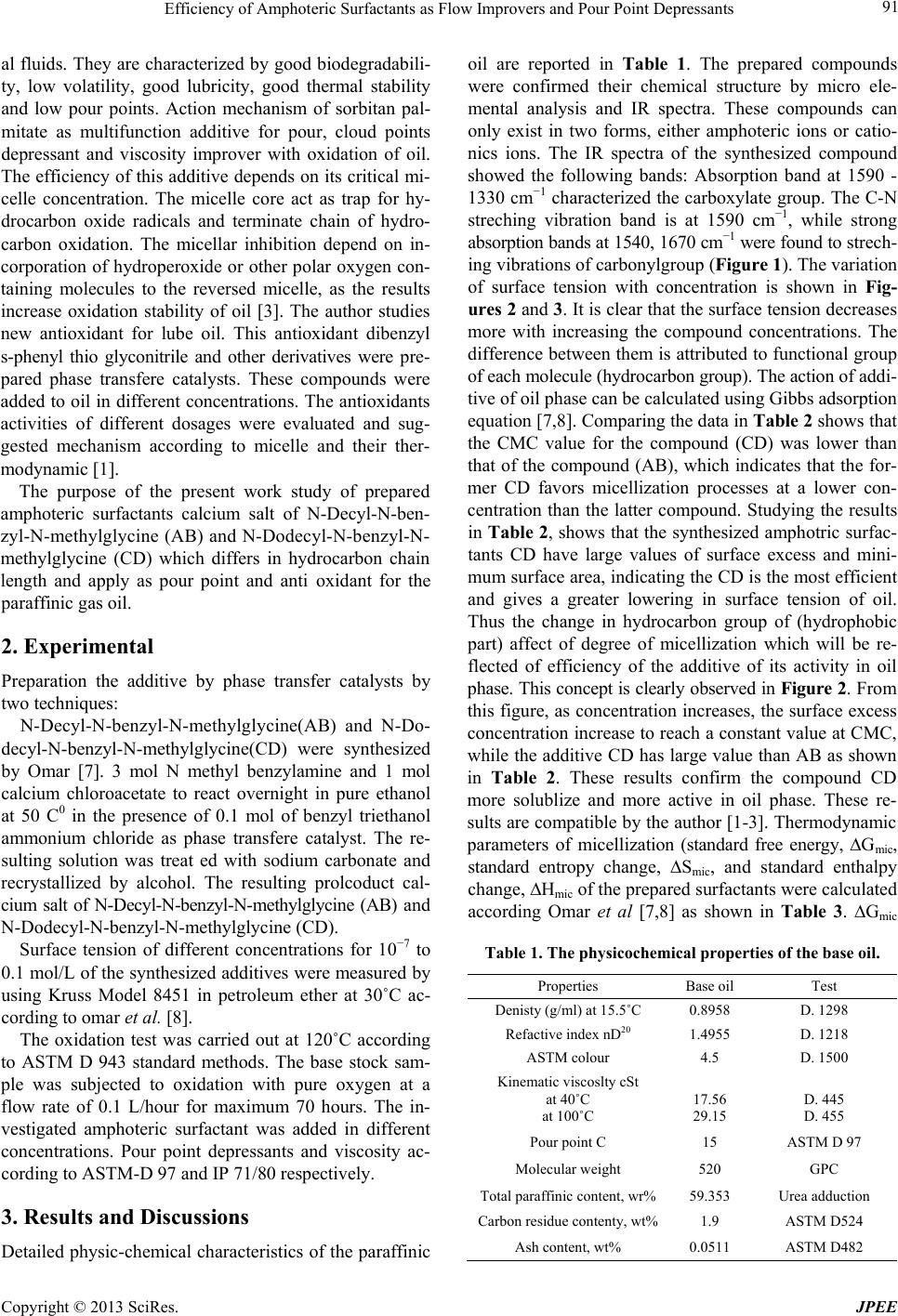
Efficiency of Amphoteric Surfactants as Flow Improvers and Pour Point Depressants
Copyright © 2013 SciRes. JPEE
al fluids. They are characterized by good biodegradabili-
ty, low volatility, good lubr icity, good thermal stability
and low pour points. Action mechanism of sorbitan pal-
mitate as multifunction additive for pour, cloud points
depressant and viscosity improver with oxidation of oil.
The efficiency of this additive depend s on its critical mi-
celle concentration. The micelle core act as trap for hy-
drocarbon oxide radicals and terminate chain of hydro-
carbon oxidation. The micellar inhibition depend on in-
corporation of hydroperox ide or other polar oxygen con-
taining molecules to the reversed micelle, as the results
increase oxidation stability of oil [3]. The author studies
new antioxidant for lube oil. This antioxidant dibenzyl
s-phenyl thio glyconitrile and other derivatives were pre-
par ed phase transfere catalysts. These compounds were
added to oil in different concentrations. The antioxidants
activities of different dosages were evaluated and sug-
gested mechanism according to micelle and their ther-
modynamic [1].
The purpose of the present work study of prepared
amphoteric surfactants calcium salt of N-Decyl-N-ben-
zyl-N-methylglycine (AB) and N-Dodecyl-N-benzyl-N-
methylglycine (CD) which differs in hydrocarbon chain
length and apply as pour point and anti oxidant for the
paraffinic gas oil.
2. Experimental
Preparation the additive by phase transfer catalysts by
two techniques:
N-D ec y l -N-benzyl-N-me t hylgl y cine(AB) and N-Do-
decyl-N-benzyl-N-methylglycine(CD) were synthesized
by Omar [7]. 3 mol N methyl b enzylamine and 1 mol
calcium chloroacetate to react overnight in pure ethanol
at 50 C0 in the presence of 0.1 mol of benzyl triethanol
ammonium chloride as phase transfere catalyst. The re-
sulting solution was treat ed with sodium carbonate and
recrystallized by alcohol. The resulting prolcoduct cal-
cium salt of N-Decyl-N-benzyl-N-methylglycine (AB) and
N-Dodecyl-N-benzyl-N-methylglycine (CD).
Surface tension of different concentrations for 10−7 to
0.1 mol/L of the synthesized additives were measured by
using Kruss Model 8451 in petroleum ether at 30˚C ac-
cording to omar et al. [8].
The oxidation test was carried out at 120˚C according
to ASTM D 943 standard methods. The base stock sam-
ple was subjected to oxidation with pure oxygen at a
flow rate of 0.1 L/hour for maximum 70 hours. The in-
vestigated amphoteric surfactant was added in different
concentrations. Pour point depressants and viscosity ac-
cording to ASTM-D 97 and IP 71/80 respectively.
3. Results and Discussions
Detailed physic-ch emical characteristics of the paraffinic
oil are reported in Table 1. The prep ared compounds
were confirmed their chemical structure by micro ele-
mental analysis and IR spectra. These compounds can
only exist in two forms, either amphoteric ions or catio-
nics ions. The IR spectra of the synthesized compound
showed the following bands: Absorption band at 1590 -
1330 cm−1 characterized the carboxyla te group. The C-N
streching vibration band is at 1590 cm−1, while strong
absorption bands at 1540, 1670 cm−1 were found to strech-
ing vibrations of carbonylgroup (Figure 1). The variation
of surface tension with concentration is shown in Fig-
ures 2 and 3. It is clear that the surface tension decreases
more with increasing the compound concentrations. The
difference between them is attributed to f unctional group
of each molecule (hydrocarbon group). The action of addi-
tive of oil phase can be calculated using Gibbs adsorption
equation [7, 8]. Comparing the data in Table 2 shows that
the CMC value for the compound (CD) was lower than
that of the compound (AB), which indicates that the for-
mer CD favors micellization pr ocesses at a lower con-
centration than the latter compound. Studying the results
in Table 2, shows that the synth esized amphotric surfac-
tants CD have large values of surface excess and mini-
mum surface area, indicating the CD is the most efficient
and gives a greater lowering in surface tension of oil.
Thus the change in hydrocarbon group of (hydrophobic
part) affect of degree of micellization which will be re-
flected of efficiency of the additive of its activity in oil
phase. This concept is clearly observed in Figure 2. From
this figure, as concentration increases, the surface excess
concentration increase to reach a constant value at CMC,
while the additive CD has large value than AB as shown
in Table 2. These results c onfirm the compound CD
more solublize and more active in oil phase. These re-
sults are compatible by the author [1-3]. Thermodynamic
parameters of micellization (standard free energy, ∆Gmic,
standard entropy change, ∆Smic, and standard enthalpy
change, ∆Hmic of the prepared surfactants were calculated
according Omar et al [7,8] as shown in Table 3. ∆Gmic
Table 1. The physicochemical properties of the base oil.
Properties Base oil Test
Denisty (g/ml) at 15.5˚C 0.8958 D. 1298
Refactive index nD20 1.4955 D. 1218
ASTM colour 4.5 D. 1500
Kinematic viscoslty cSt
at 40˚C
at 100˚C
17.56
29.15
D. 445
D. 455
Pour point C 15 ASTM D 97
Molecular weight 520 GPC
Total paraffinic content, wr% 59.353 Urea adduction
Carbon residue contenty, wt% 1.9 ASTM D524
Ash content, wt% 0.0511 ASTM D482